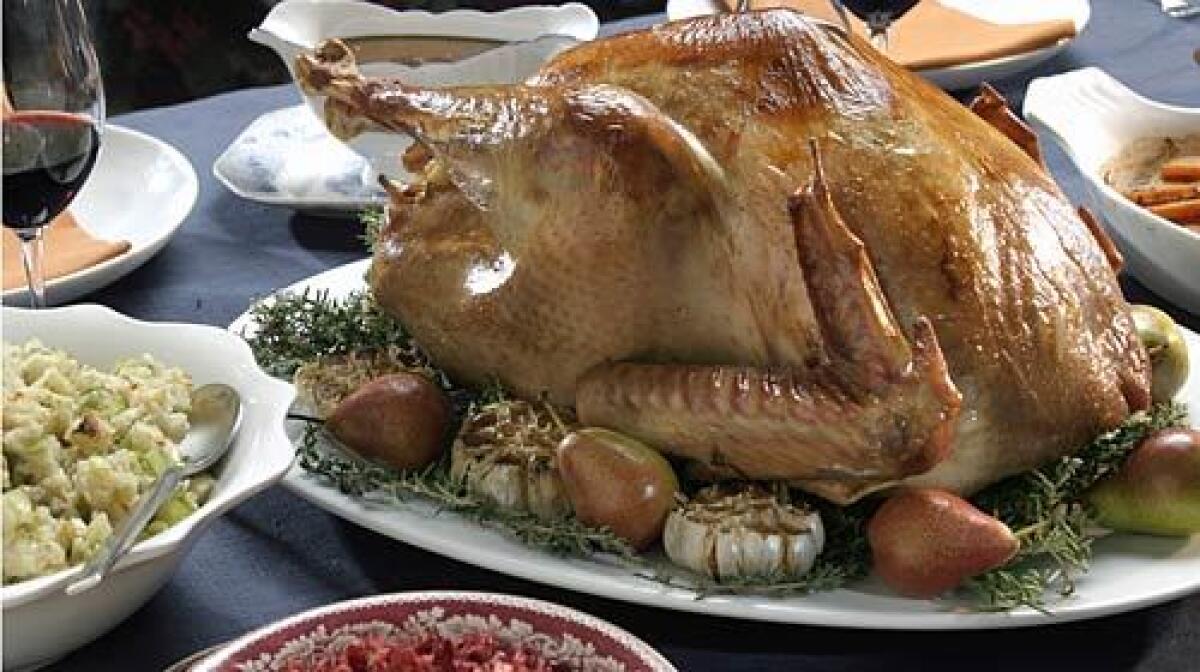Fit for a Pilgrim

- Share via
Only in the food world is reverse evolution a good thing. Every November, turkey, the all-important element of the most unifying American meal, gets a little closer to what the Pilgrims ate at that very first feast when they were grateful just to be alive. And every November it gets better.
In the last 20 years, frozen Butterballs have given way even in supermarkets to fresh turkeys, then free-range turkeys and most recently organic turkeys. Now all those relatively tame birds bred to sameness over the last half a century are very slowly starting to be supplanted by turkeys with stunning flavor and texture that may not be totally wild but are much richer and more nuanced than the usual tom or hen.
Known as heritage turkeys (“heirloom” was apparently taken by tomatoes and apples), these birds are truly the essence of Thanksgiving. Everything about them takes you back in time to a purer world of food.
Unlike the Broad-Breasted Whites developed to dominate the holiday (representing 99.9% of what is sold each season, according to Heritage Foods USA, which markets American Bronze and Bourbon Red breeds), they have sturdy legs and flatter, longer breasts with stunning flavor. Their white meat would never be mistaken for chicken, and their dark meat is rich and sensuous as duck.
You don’t need to drown a heritage turkey in gravy, let alone look at it as just another shade of beige on the dinner plate. Investing in one will make you refocus on what the meal is all about.
Even better, cooking one will teach you a whole new way of tackling every other turkey: Just do it.
In the last five years, brining has been Step 1 of Thanksgiving preparations because steeping the bird in a spiced mixture of salt, sugar and water truly does transform even the driest meat into a juicy-tasty sensation. But heritage turkeys have inherent flavor that brining would subvert. Tossing a heritage bird naked into an oven would produce leathery legs and chewy breasts -- with superb taste but not at their best.
The good news is that an old-fashioned way of cooking will transform a heritage turkey -- or in fact any bird. The method? Just roast it covered. The effect is dramatic: You’ll taste turkey first, not back notes of salt. And when you try it with a regular turkey, you will get even richer rewards.
Frank Reese, a Kansas breeder at Good Shepherd Ranch who has single-mindedly kept alive two breeds otherwise lost to mainstream genetic alterations, says his mother and grandmother always cooked their birds in an open roaster with a little water to keep them from drying out. The meat, however, is more steamed or braised than roasted. Omitting the water and simply covering the pan for the first two-thirds of the cooking time produces a better effect. An old-fashioned Granite Ware covered roaster does the job perfectly. (Tenting with foil lets too much steam escape, and the white meat dries out.)
The turkey essentially braises in its own juices until it is mostly cooked, then you remove the lid to let the skin brown and crisp. Pan-roasting this way creates juicy meat, crunchy skin and the most concentrated flavor imaginable.
The sealed pan captures the strong natural flavors of the turkey, but you can also add herbs and garlic. Whole bunches of rosemary and thyme amplify the aromas and flavors of the sage, onion and celery in the usual stuffing. And that combination works the same magic on a regular turkey -- whether organic, free-range or just fresh -- as it does on a heritage bird. (But not much can save a frozen bird already injected with artificially flavored oil.)
No pain, a lot of gain
ASIDE from adjusting the oven temperature setting a few times, this technique is virtually painless, almost carefree, compared with basting. Both types of turkey cook in about the same amount of time, and both truly benefit from being contained in a covered roaster. Even the best free-range turkey will taste more like a Pilgrim’s dream when the meat is succulent. If you’re tired of turning over half the refrigerator to a potful of brine with bird inserted, this will change your holiday forever.
Both heritage and regular turkeys benefit from an extra step, though, one that can be done while you are slicing bread and chopping celery, onions and sage for stuffing.
Coating the skin with a dry rub of kosher salt, sugar, chile powder and smoked paprika will help to draw out excess liquid so that the skin cooks crisp, with amazing undertones of flavor, even though it will be covered for most of the roasting time. (Kosher salt, of course, is coarse enough not to get trapped in drumstick nooks and crannies and produce a too-salty bird.) The two types of pepper, chile and paprika, also help color the skin. You could use regular paprika, but the smoked variety adds a really fascinating hint of outdoorsy flavor.
This dry rub, as barbecue aficionados call it, also has the benefit of eating up time so that the turkey is not refrigerator-cold when you slide it into the oven. It roasts quicker and more evenly as a result.
And whether you start with a flavorful heritage turkey or a high-end but bland free-range, it certainly beats brining. You get all turkey flavor with less prep, sumptuous meat with no basting and crispy skin with no stress.
As one last bonus, the roasting method, uncovered at halftime, also intensely perfumes the kitchen just before the meal comes together.


